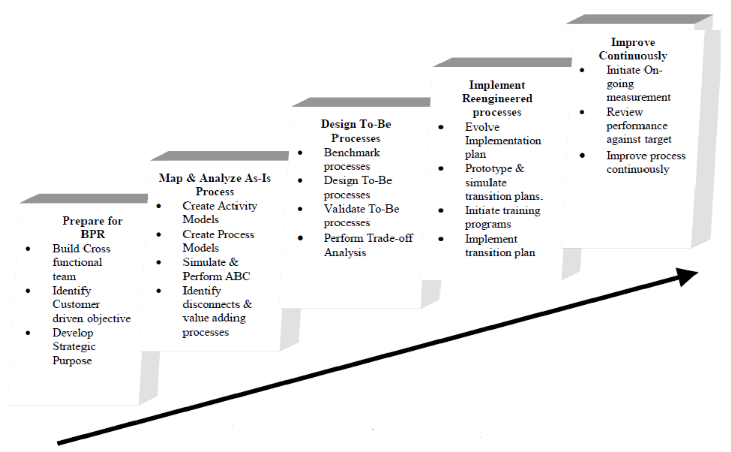2.5.2: Business Process
Reengineering (BPR)
Business process reengineering is also known as Business
Process Redesign, Business Transformation, or Business Process Change
Management. Reengineering is a fundamental rethinking and radical redesign of
business processes to achieve dramatic improvements in cost, quality, speed,
and service. BPR combines a strategy of promoting business innovation with a
strategy of making major improvements to business processes so that a company
can become a much stronger and a more successful competitor in the marketplace.
It encompasses the envisioning of new work strategies, the actual process
design activity, and the implementation of the change in all its complex
technological, human resource, and organizational dimensions [17].
Reengineering is an approach aimed at redesigning the way work
is done to better support the organization's mission and reduce costs. It
starts with a high-level assessment of the organization's mission, strategic
goals, and customer needs. Within the framework of this basic assessment of
mission and goals, reengineering focuses on the organization's business
processes--the steps and procedures that govern how resources are used to
create products and services that meet the needs of particular customers or
markets. Reengineering identifies, analyzes, and redesigns an organization's
core business processes with the aim of achieving dramatic improvements in
critical performance measures, such as cost, quality, service, and speed. It
focuses on redesigning the process as a whole in order to achieve the greatest
possible benefits to the organization and their customers. This distinguishes
reengineering from process improvement efforts that focus on functional or
incremental improvement [16].
A key stimulus for reengineering has been the continuing
development and deployment of sophisticated information systems and networks.
Generally business processes are not reengineered simultaneously; they are done
based on the following criteria:
Ø dysfunction: which processes are functioning
the worst?
Ø importance: which are the most critical and
influential in terms of customer satisfaction
Ø feasibility: which are the processes that
are most likely to be successfully reengineered
The five main established methodologies from contemporary
literature used in reengineering business processes and the activities in
chronological order include
Reengineering methodology 1 [22]
1. Develop vision and strategy
2. Create desired culture
3. Integrate and improve enterprise
4. Develop technology solution
Reengineering methodology 2 [19]
1. Determine requirements and goals for the process
2. Map and measure existing process
3. Analyze and modify existing process
4. Design a reengineered process
5. Implement the reengineered process
Reengineering methodology 3 [18]
1. Set direction
2. Baseline and benchmark
3. Create the vision
4. Launch problem solving projects
5. Design improvements
6. Implement change
7. Embed continuous improvement
Reengineering methodology 4 [21]
1. Motivating reengineering
2. Justifying reengineering
3. Planning reengineering
4. Setting up for reengineering
5. As-Is description and analysis
6. To-be design and validation
7. Implementation
Reengineering methodology 5 [20]
1. Preparation
2. Identification
3. Vision
4. Technical and social design
5. Transformation
A consolidated methodology has been developed from the above
five methodologies by taking into consideration their common attributes and
differences. This consolidated methodology is depicted in the process flow
diagram below, which shows the main processes and the activities involved

Figure 16: Business
process reengineering consolidated methodology [7]
| 


